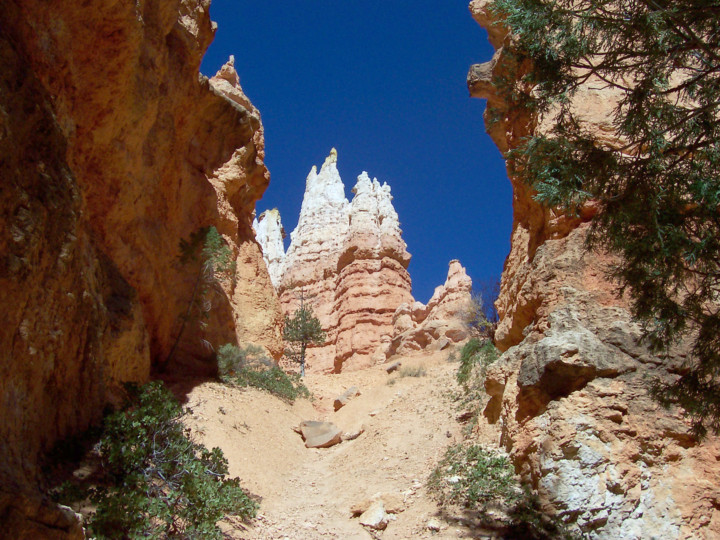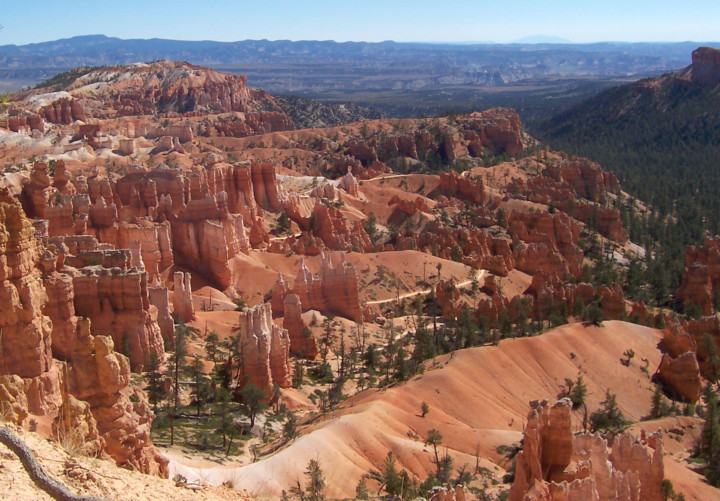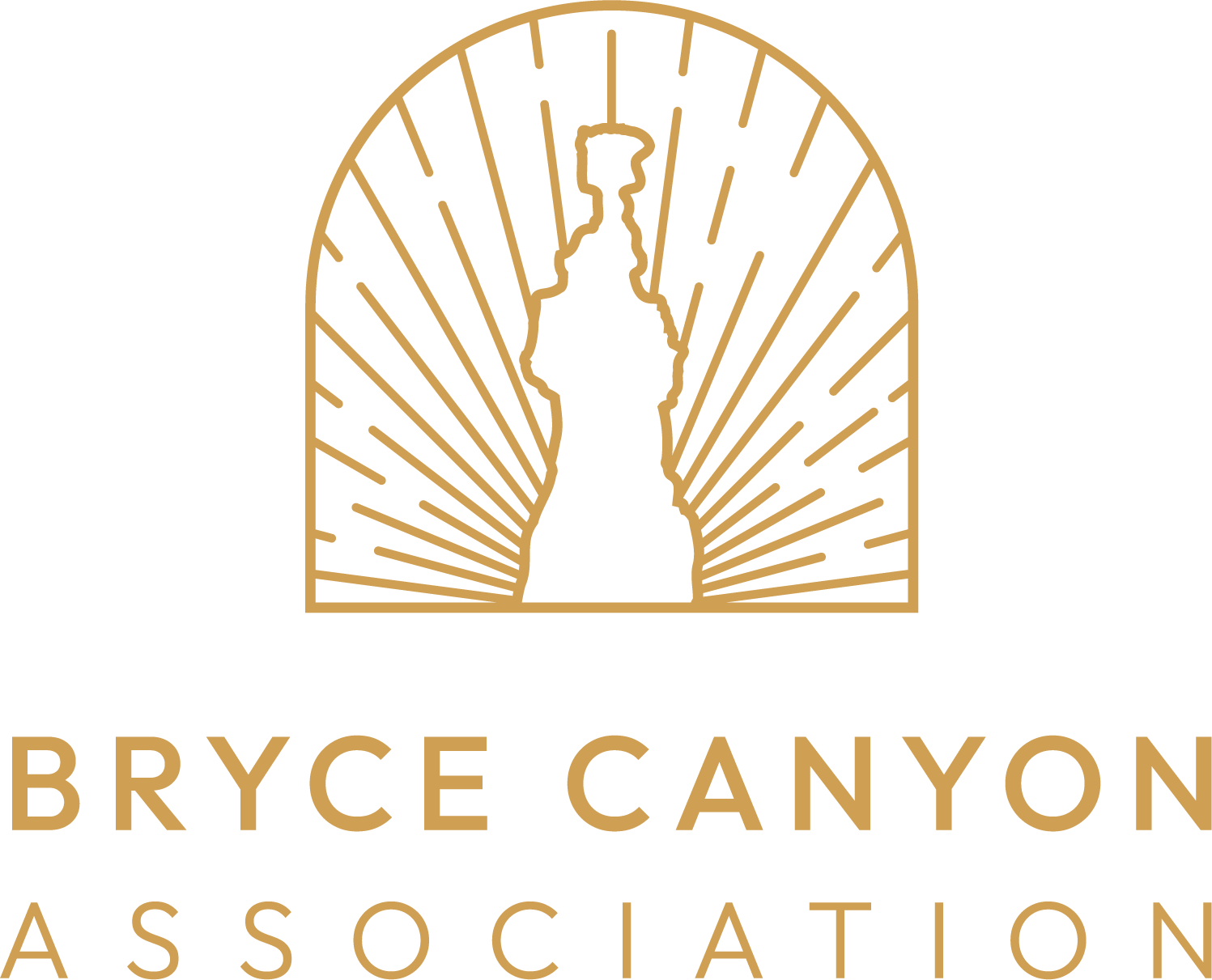BRYCE CANYON, Utah: My daughter, Katie, is a scenic-overlook minimalist.
She might argue that, but one or maybe two overlooks in a park or along a drive are enough for her. She will enjoy the views but repeated, never-ending views are too much for her.
It’s a genetic trait Katie inherited from my wife, Pat, who enjoyed one sand dune overlook above Lake Michigan near Traverse City, Mich., not No. 4 or No. 5, no matter how equally stunning.
My philosophy is that one can never have too many scenic overlooks and photo ops (unless you are driving along the Blue Ridge Parkway in the East).
Those disparate family travel approaches came into conflict in southern Utah at stunningly beautiful Bryce Canyon National Park, which has thousands of whimsical hoodoos, photogenic rock chimneys.
There are 13 overlooks along the park’s 18-mile Rim Road. Do we stop at every one, most of them or one of them? We compromised and made multiple stops. But we did skip some, grudgingly. Ah, family trips.
Those overlooks offer eye-popping 100-mile vistas across the Paunsaugunt Plateau and the Paria River, and lots of views of the park’s iconic hoodoos, and that’s the way that most visitors see Bryce Canyon.
It’s one of America’s most distinctive and colorful national parks. There is nothing else like it, a fairyland of red, orange and white rock spires that look like they were created by Dr. Seuss.
The weirdly shaped hoodoos, up to 150 feet tall, were created 40 million to 60 million years ago by eroding water from the surrounding plateau and 200 freeze-thaw cycles per year.
The Paiute Indians believed the rocks were animal-like creatures who changed into people with red-painted faces. But they were so bad that the Spirit Coyote turned them into stone.
Bryce Canyon is the largest collection of hoodoos in the world. They have also been called fairy chimneys and goblins.
It is a gawkers’ park, a spectacular badlands that is bewitching and enchanting, not intimidating. It is a wild land of details. The color shifts with available light; what you see in the morning is different than in the afternoon or at twilight.
There are warm yellows, browns, oranges, pinks, reds, greens, whites and purples in the bizarrely shaped spires and monoliths, fins, fluted walls, sculptured pinnacles and deep ravines. It has been reported that Bryce Canyon is home to 65 different colors of rock.
The colors are especially stellar after rains and snows, and the park looks like the Martian surface at sunrise.
In looking at the hoodoos, it almost looks like they grew up out of the Earth like oversized stalagmites. Some are sturdy. Others are very delicate-looking.

: Visitors to Bryce Canyon Natural Park can explore the parks distinctive hoodoos on hikes that descend into the rocky formations. The park features 50 miles of hiking trails. (Bob Downing/ABJ/Ohio.com correspondent)
Some have names: Sinking Ship, Thor’s Hammer, China Wall, Queen Victoria, the Silent City, Tower Bridge, Wall Street, Three Wise Men, Wall of Wonder, Queen’s Garden and Table Cliffs.
Bryce Amphitheater, the park’s biggest attraction, is surrounded by four overlooks. It is a horseshoe-shaped, pastel-colored rock bowl that covers six square miles, one of about a dozen hoodoo-filled amphitheaters in the 35,835-acre park.
Natural Bridge is 85 feet high and 125 feet wide. It was carved not by a stream but by rain and frost.
The park service suggests at least three hours to drive Rim Road. They suggest driving to the end of the parkway and then returning, so that all the parking areas will be on your right and you won’t have to cross heavy traffic to reach them.
Some swear the best views are at dawn from Bryce Point and Sunrise Point. Others love late afternoon at Sunset Point. Others opt for sunset at Inspiration Point or Paria Point. The best long-distance views come from Rainbow, Farview and Yovimpa points.
Park visitors can hike into the hoodoos on 50 miles of trails, and it’s one of the best ways to get an up-close look at the canyon first settled by Ebeneezer Bryce in 1875.
Short options include the 1.8-mile Queen’s Garden Trail and the 1.3-mile Navajo Loop, both from Sunrise Point. You lose and gain 320 feet elevation on the Queen’s Garden Trail. On the Navajo Loop, hikers will lose/gain 521 feet in a series of tight switchbacks. That will take you to Wall Street, a narrow spot with skyscraper rock cliffs. It is a moderately tough hike into the main amphitheater and one of the most popular trails.
There are longer options like the 23-mile Under the Rim Trail with eight campsites, and the 9-mile Riggs Spring Trail. The easy 11-mile Rim Trail runs along the top between Fairyland Point and Bryce Point.
Dirt and rock slides are a risk. They have occurred in 2006, 2010 and 2011.
You can hop on the Bristlecone Loop Trail at Rainbow Point. The trail will take you to some of the park’s very old bristlecone pines.
Bryce Canyon is really not a canyon at all, just the eroded edge of a plateau.
Most of the park lies at elevations between 8,000 and 9,000 feet. That means snow comes early and stays late, typically 96 inches of snow a year. That freeze-thaw cycle contributes to the erosion that created the unusual geology.
Bryce Canyon is also known for its super-dark starry night skies. It is away from urban lights and has clean air. You will typically see up to 7,500 stars with the naked eye, three times more than you would see in the Midwest. You can even hike into the hoodoos at night, if your visit is timed to a full moon.
The park is surrounded by the Dixie National Forest, a long-ago hideout of outlaw Butch Cassidy.
It is 78 miles from Bryce Canyon to Zion National Park in southern Utah with its famous slot canyons, and 150 miles to the North Rim of Grand Canyon National Park in northern Arizona. State Route 12 at the park’s entrance runs east to Escalante and Boulder through wild and rugged country. At Bryce, you are also only 20 miles from Grand Staircase-Escalante National Monument.
Bryce Canyon gets nearly 2.4 million visitors a year.
It was heavily promoted by the Union Pacific Railroad in the ’20s. Here is how the railroad, in its promotional materials, described the hoodoos: “There bursts upon [the visitor’s] amazed eyes what is probably the most astonishing blend of exquisite beauty and grotesque grandeur ever produced by the forces of erosion. It is not to be described, however imperfectly, except in the language of fancy.”
The park provides a visitors’ center, lodge, motel rooms and cabins from April through October, campgrounds, restaurant and general store.
The park itself is open year-round. The main road is plowed in the winter.
Admission is $35 per car for seven days. The park offers a voluntary shuttle bus service along Rim Drive from mid-April through October.
For park information, call 435-834-5322 or go to http://www.nps.gov/brca.
To order a trip planning packet or an official bryce canyon t-shirt go to www.brycecanyon.org
The lodge is managed by Forever Resorts. For information, call 435-834-8700 (lodge) or 877-386-4383 (reservations) or go to http://www.foreverresourts.com.

Hoodoos or rocky chimneys are the iconic feature at Bryce Canyon National Park in southern Utah. They are also called fairy chimneys and goblins. (Bob Downing/ABJ/Ohio.com correspondent)
